June 17, 2025 | 23:32 GMT +7
June 17, 2025 | 23:32 GMT +7
Hotline: 0913.378.918
June 17, 2025 | 23:32 GMT +7
Hotline: 0913.378.918
Quang Ninh, with approximately 370,000 hectares of forest land, ranks among the top provinces in Vietnam for forest coverage, at around 55%. Besides organizing land and forest allocations to individuals and communities, the province also focuses on planting and expanding hundreds of hectares of mangrove forests each year, making it the area with the largest mangrove forest coverage in northern Vietnam.
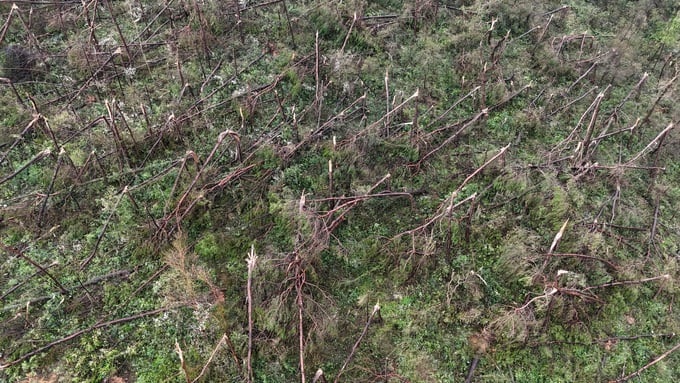
About 110,000 hectares of forest in Quang Ninh were damaged after Typhoon Yagi. Photo: Tien Thanh.
However, that progress has been set back by the impact of Typhoon Yagi (Storm No. 3). According to Deputy Director of the Department of Agriculture and Rural Development, Vu Duy Van, only about one-quarter of the province’s planted forests remain intact, with approximately 10,000 hectares undamaged. Several forestry companies were severely affected, including Tien Yen, where not a single tree survived, and Ba Che, which has just over 100 hectares of forest left.
It took Quang Ninh around 10 years to achieve its current levels of timber and forest product supplies. However, after the recent storm, around 110,000 hectares of forest were devastated. Even more critically, transportation infrastructure has been paralyzed, as 11 out of 13 wood chip transport systems to the port were destroyed, making it difficult for ships to enter and transport goods.
In addition to the drop in raw material prices, Quang Ninh also faces the risk of a significant decrease in forest coverage. If upcoming survey data confirms current estimates, Mr. Van predicts that the province’s forest coverage could decrease by over 10%, reverting to levels seen in the 1990s.
"The damage may increase further, as many areas of mangrove forests have been washed away, and trees have been uprooted by the storm surge. However, authorities have been unable to assess the full extent of the damage due to ongoing heavy rains and high tides," Mr. Van noted, adding that the final damage report is likely to be more severe.
A 10% decrease in forest coverage is also the estimate given by Tu Quoc Huy, Head of the Bac Giang Forest Protection Department, when asked about the expected loss. According to him, as of September 23, nearly half of the province’s more than 100,000 hectares of planted forest had been damaged by the storms. In areas where damage exceeds 70%, the affected area totals about 14,000 hectares.
Several mountainous districts, such as Son Dong and Luc Ngan, have been hit particularly hard. As of September 23, landslides continued to cause extensive damage to forests, homes, infrastructure, and other constructions. In certain residential areas, such as An Ba, Tuan Dao, and Yen Dinh communes in Son Dong district, residents remain in a state of fear, as their houses are precariously situated against mountain slopes.
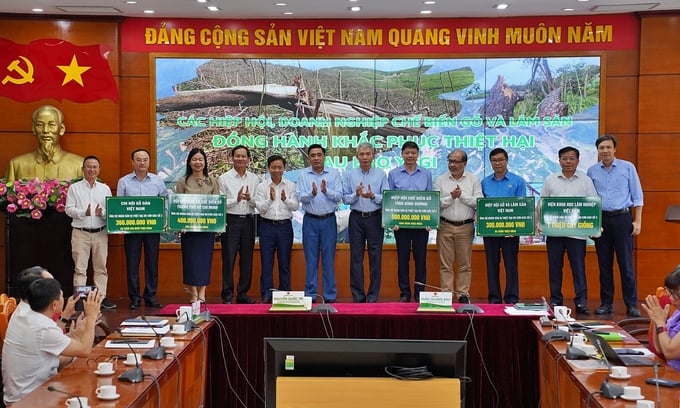
Many organizations and individuals have donated money and goods to help locals stabilize their production after the floods. Photo: Bao Thang.
The Head of the Department also shared unfortunate news: the price of raw timber has dropped by about 370,000 VND/ton compared to pre-storm levels. On average, forest owners in Bac Giang have lost close to 50 million VND per hectare.
“The reported figure of 26,000 hectares of damaged forest is certainly not the final statistic,” Mr. Huy noted.
According to the Forestry Department, Quang Ninh and Bac Giang are the two provinces that have suffered the most forest damage from Typhoon Yagi. As of September 23, a total of 13 provinces and cities had experienced forest destruction, affecting about 170,000 hectares (excluding natural forest areas lost to erosion and landslides).
In addition to the impact on raw material areas, wood processing enterprises have faced compounded losses. According to the Vietnam Timber and Forest Products Association, enterprises affiliated with the association have suffered losses amounting to approximately 130 billion VND due to damage to factories, products being washed away, and equipment being destroyed. The Wood Pellet Association has reported losses of about 70 billion VND, while the Wood Chip Association estimates damages of around 310 billion VND.
Tran Quang Bao, Director of the Forestry Department, warned of a potential disruption in the raw wood supply chain over the next few years. He explained that with the typical 5-7 year cycle for planting fast-growing trees, the supply of raw wood from domestic forests could decrease by approximately 3.5 million cubic meters per year due to the damage from Typhoon Yagi (Storm No. 3). This is because the storm-damaged areas will need 5-7 years before they can be harvested again.
The 2024 export target for wood and forestry products stands at $15.2 billion USD, presenting a significant challenge for the entire industry. "To urgently address the aftermath of Storm No. 3, it is essential to attract more economic sectors to participate in the development of planted forests and the processing of wood and forestry products," Mr. Bao emphasized.
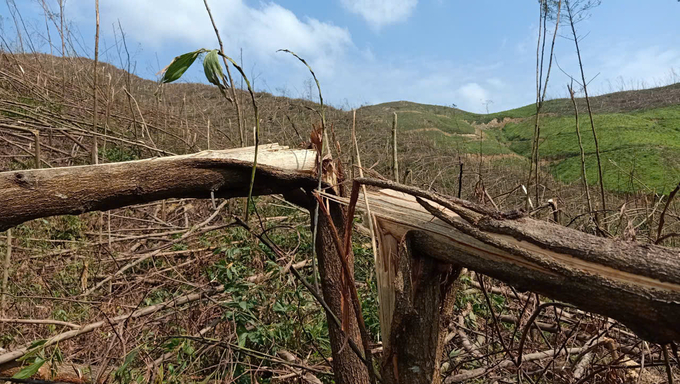
Planted forests in Hoanh Bo district, Quang Ninh province damaged by Typhoon Yagi. Photo: Quynh Huong.
Recently, the Forestry Department issued Official Letter No. 1339/LN-PTR, providing guidance to localities on how to recover from forest damage caused by Typhoon Yagi. The directive includes measures for protecting and encouraging natural forest regeneration, or safeguarding regeneration combined with supplemental planting to restore forests and enhance forest quality.
The Department also provided guidelines on assessing the extent of forest damage using both traditional and modern technological methods. However, traditional approaches have limitations, as many areas have been eroded or experienced landslides, making access and transportation difficult. While GPS and drone technology offer more precise assessments, they require additional time for data synchronization.
In response to these challenges, Deputy Minister of Agriculture and Rural Development Nguyen Quoc Tri suggested that associations and industries work together to address the immediate need for processing fallen and broken trees as raw materials, especially for wood chip production.
"I am aware that many units have already devised proactive plans," he said, recommending that future plans include securing raw wood supplies for processing to alleviate pressure on the input supply chain. Possible solutions include increasing the procurement of planted wood from areas unaffected by Typhoon Yagi and reducing the export of raw wood abroad, among other strategies.
In the long term, the Ministry of Agriculture and Rural Development has emphasized the need for detailed and accurate statistics on the damaged forest areas. These statistics will serve as the foundation for determining compensation levels and providing support to forest growers. Moreover, this data will be crucial for planning forest regeneration, reforestation, and protection efforts, especially as the rainy and stormy season is expected to continue for several more months.
To expedite recovery from the storm, Deputy Minister Nguyen Quoc Tri urged localities to "remain flexible" and suggested that they could "utilize funds designated for alternative forest planting." In Quang Ninh, for instance, this fund amounts to approximately 300 billion VND.
Reforestation has recently gained considerable attention across the country, aligned with Vietnam’s commitment to achieving net-zero emissions by 2050. From an administrative standpoint, the current forestry laws allow investors to make advance payments to expedite project implementation, providing localities with more financial resources to enhance reforestation efforts.
With the issuance of Decree 58/ND-CP at the end of May 2024, which increased the annual forest protection support to 500,000 VND per hectare, the Deputy Minister called on management agencies and local authorities to focus on the various groups involved in replanting (such as special-use forest management boards, protection forests, forestry companies, and commune-level authorities). He also stressed the importance of clarifying key aspects like planting locations and funding amounts to ensure fair and adequate support.
"Given the extent of the damage, we estimate that around 300-350 million seedlings will be needed to restore the forests. In addition to sourcing seeds from the Vietnam Forestry Science Institute, localities should proactively reach out to seed production facilities in other provinces to secure sufficient supplies," said Deputy Director Tran Lam Dong.
Translated by Quynh Chi
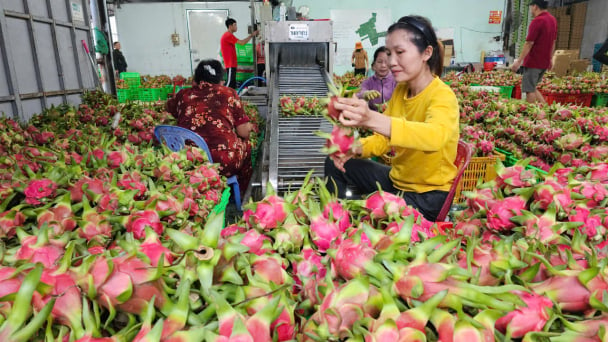
(VAN) According to the Binh Thuan Department of Industry and Trade, in the first five months of 2025, Binh Thuan's dragon fruit export turnover increased by 20.65% compared to the same period last year.

(VAN) EU countries on Thursday gave final approval to new tariffs on fertilizer imports from Russia, a move aimed at cutting off revenue that could support Moscow’s war in Ukraine, despite concerns from European farmers.
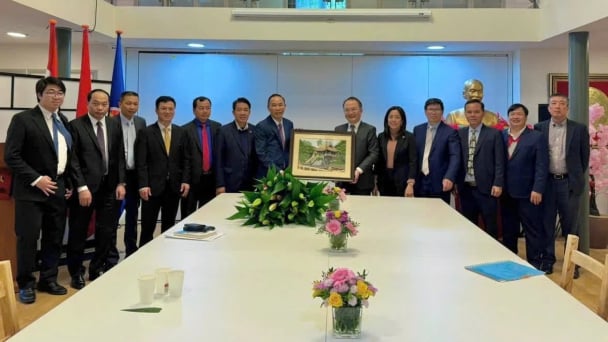
(VAN) The working delegation from the Ministry of Agriculture and Environment conducted an important trip to the Netherlands to strengthen strategic partnerships and sustainable development in the agricultural sector.

(VAN) The letter ‘A Plea from the Ocean’ not only evokes emotion but also awakens the human conscience to the responsibility of protecting life on Earth.

(VAN) The Department of Agriculture in South Africa has announced the country’s first mass vaccination of poultry to prevent local birds from contracting avian influenza.

(VAN) Establishment of the Mekong Delta Regional Agricultural Linkage Center, aiming for a closed value chain, deep processing, trading platforms, and international market connectivity.

(VAN) Gia Lai province has recently recorded 460 rare species of animals and plants, contributing to forest conservation and biodiversity planning in the region.